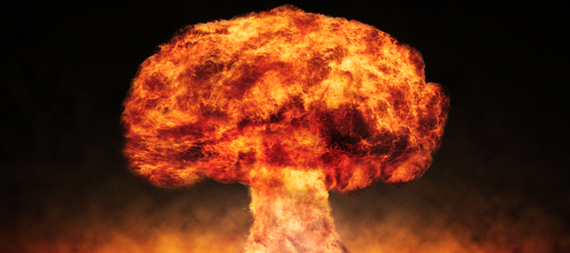Twice every year, 15 experts meet to discuss the possibility of apocalypse -- this group, called the Science and Security Board are the timekeepers of our race. In the latest episode of the Intersection, we speak to two of them -- Sivan Kartha and Rachel Bronson. The duo helped in devising a Doomsday Clock, a mechanism that represented the existential threat to humanity. In 1947, this clock was published on the cover of the magazine Bulletin of Atomic Scientists. After the Second World War, Albert Einstein and Robert Oppenheimer created a Board of Sponsors, a group that also gives their input about where the hands of the Doomsday clock will rest.
![2016-05-24-1464087654-1503771-Blog_Audiomatic.png]()
The history of the clock is marked by extreme fluctuations -- it was closest to midnight at 11:58 when the Cold War was at its height and the world was reeling from American and Soviet tests of hydrogen bomb. But, when was it furthest from Doomsday? In 1991, when the Cold War ended -- it was turned back to 11:43!
The clock quantifies threats by taking many worldwide factors into account and the Board realistically assesses the total existential risk that mankind is facing. While the Board initially only considered nuclear threats, in the past decade it has also taken into account climate change, bioterrorism and cyber threats. In 2012, the hands were poised at 11:55, but in 2015, scientists decided to move it forward to 11:57. This occurred due to a series of events that had a mixed impact -- while the Iran nuclear agreement and the recent Paris climate accord mean that we are making gigantic strides towards conserving our environment and maintaining peace, nuclear tensions between the United States and Russia have grown in spite of the Nuclear Non-Proliferation Treaty and the recent tests of North Korea's hydrogen bomb have left the world aghast. Both India and Pakistan have also increased their nuclear arsenal, increasing tension in South-East Asia.
What will help the hands of the clock turn back? What will take us further away from apocalypse? World leaders must reduce the proposed spending on programs that aim to modernise nuclear weapons and engage with North Korea in order to reduce nuclear risks. They must also stay true to the Paris accord, and follow up on the actions agreed upon to reduce green-house gas emissions and keep global warming at less than two degrees Celsius in order to curb climate change.
Listen to the podcast above to know how the Doomsday Clock is managed and on what basis it's time is decided.
![]() Like Us On Facebook |
Like Us On Facebook |
![]() Follow Us On Twitter |
Follow Us On Twitter |
![]() Contact HuffPost India
Contact HuffPost India
Also see on HuffPost:

The history of the clock is marked by extreme fluctuations -- it was closest to midnight at 11:58 when the Cold War was at its height and the world was reeling from American and Soviet tests of hydrogen bomb. But, when was it furthest from Doomsday? In 1991, when the Cold War ended -- it was turned back to 11:43!
The clock quantifies threats by taking many worldwide factors into account and the Board realistically assesses the total existential risk that mankind is facing. While the Board initially only considered nuclear threats, in the past decade it has also taken into account climate change, bioterrorism and cyber threats. In 2012, the hands were poised at 11:55, but in 2015, scientists decided to move it forward to 11:57. This occurred due to a series of events that had a mixed impact -- while the Iran nuclear agreement and the recent Paris climate accord mean that we are making gigantic strides towards conserving our environment and maintaining peace, nuclear tensions between the United States and Russia have grown in spite of the Nuclear Non-Proliferation Treaty and the recent tests of North Korea's hydrogen bomb have left the world aghast. Both India and Pakistan have also increased their nuclear arsenal, increasing tension in South-East Asia.
While the Board initially only considered nuclear threats, in the past decade it has also taken into account climate change, bioterrorism and cyber threats.
What will help the hands of the clock turn back? What will take us further away from apocalypse? World leaders must reduce the proposed spending on programs that aim to modernise nuclear weapons and engage with North Korea in order to reduce nuclear risks. They must also stay true to the Paris accord, and follow up on the actions agreed upon to reduce green-house gas emissions and keep global warming at less than two degrees Celsius in order to curb climate change.
Listen to the podcast above to know how the Doomsday Clock is managed and on what basis it's time is decided.
 Like Us On Facebook |
Like Us On Facebook |  Follow Us On Twitter |
Follow Us On Twitter | Also see on HuffPost:
-- This feed and its contents are the property of The Huffington Post, and use is subject to our terms. It may be used for personal consumption, but may not be distributed on a website.